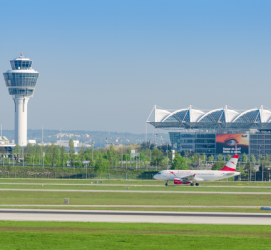Case Study: Improving the check-in passenger experience at Munich Airport
26 January 2019 | By Copenhagen Optimization
Munich Airport worked with Copenhagen Optimization with the aim of improving the passenger experience at check-in for Terminal 1.
List view / Grid view


Website: www.munich-airport.com
Munich International Airport is the second busiest airport in Germany and is the main airport for passengers visiting Bavaria. It is located nearly 30 km outside the city, near the town of Freising.
Also known as Franz Josef Strauss Airport, it has two runways and two passenger terminals and features facilities for cargo transport and aircraft maintenance.
26 January 2019 | By Copenhagen Optimization
Munich Airport worked with Copenhagen Optimization with the aim of improving the passenger experience at check-in for Terminal 1.
Dr Michael Kerkloh, President of ACI EUROPE and CEO of Munich Airport, commented on the potential impact of Brexit, recent drone disruptions and the need for alignment in airport capacity, investment and user charges, at ACI Europe's New Year Reception.
To diversify its business offerings, Munich Airport has developed LabCampus, a subsidiary of the airport which will provide a cross-industry innovation centre. Managing Director of LabCampus, Dr Marc Wagener, reveals how the new venture will benefit the champions of the innovation sector.
Dr. Michael Kerkloh, who has served as the President and CEO of Flughafen München GmbH (FMG) for over 17 years and has been on the International Airport Review Advisory board since 2011, will retire at the end of 2019.
The agreement will see the development of a smart city concept at Munich Airport in the hope that the design and development of products and services for the world of the future will be tested onsite.
Munich Airport has embarked on a partnership with Rentalcars Connect and the result is a frictionless travel experience for the airport’s 44 million annual passengers.
Quintiq, a Dassault Systèmes company and global leader in supply chain planning and optimisation (SCP&O), has been selected to improve Lufthansa Cargo’s production planning at two of its most relevant hubs in Frankfurt and Munich...
Julia Schmidt, Manager of Innovation and Digitisation at Munich Airport, reveals the airport’s innovative use of robotics equipped with artificial intelligence to benefit the passenger experience, with the creation of Josie Pepper.
From the ever-increasing use of self-service, to the streamlining of security processes, to the deployment of innovative new technologies such as robotics and artificial intelligence, the way that airports process their passengers is changing. This In-Depth Focus profiles some of the innovative ways airports are embracing new technology to the…
A good year for aviation has meant a good year for Munich Airport as the Bavarian hub posts annual revenues of around €1.5 billion.
Aerospace, digitalisation, energy and mobility will be just some of the areas industry experts will focus on at a new innovation hub in Munich Airport.
A first for German airports, Josie Pepper's brain is based on IBM Watson technology, a question and answer computer system specifically developed to answer questions from the quiz show Jeopardy.
Like many airports, the threat of cyber attack is ever present for Munich International Airport. In a move designed to combat it, its operator has set up a unique centre to develop defensive strategies and train people from inside or outside the aviation industry.
12 December 2017 | By
Munich International Airport (MUC), also known as Franz Josef Strauss International Airport, is the second busiest airport in Germany and is the main airport for passengers visiting Bavaria.
Munich Airport and Moscow Domodedovo have signed a sister airport agreement, the seventh such arrangement for the German airport.